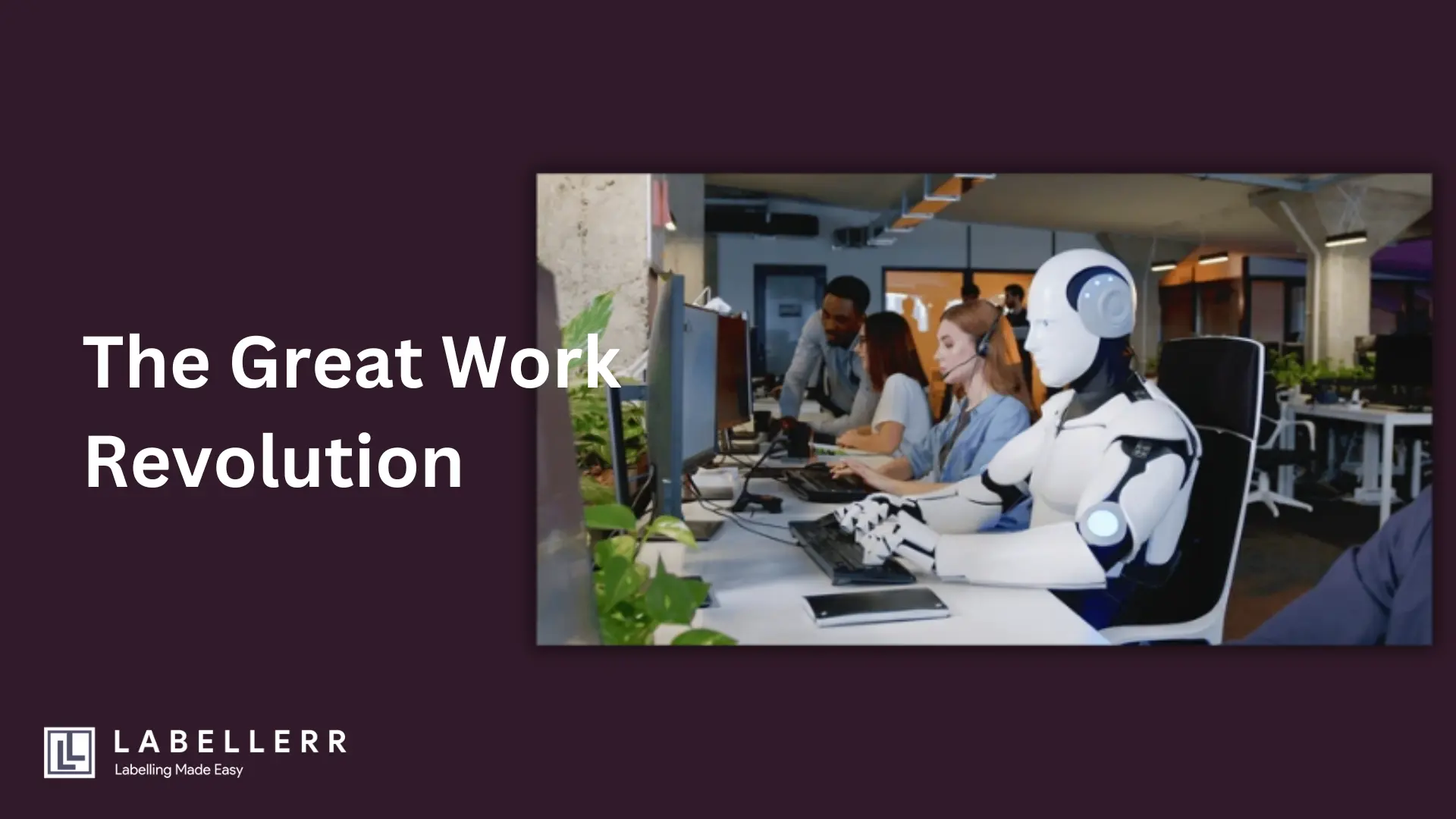Bye-Bye 9-to-5: How AI is Redefining Work as We Know It!
AI is redefining work as we know it, automating tasks, enabling flexible schedules, and challenging the traditional 9-to-5 grind. From AI-driven decision-making to autonomous agents handling workflows, the future of work is dynamic, decentralized, and more efficient than ever.

The traditional 9-to-5 work model is changing fast, thanks to AI and shifting social preferences. AI agents can perform tasks without human prompts.
How do they achieve this? Well, by automating repetitive work and offering more flexible work options. This shift is boosting productivity and turning rigid work schedules into more dynamic and personalized workflows.
Experts see a big impact of AI on the workplace. Microsoft CEO Satya Nadella says "AI will transform knowledge work by blending smoothly with human tasks." He believes "AI won't just take over jobs but will also create new roles, expanding the scope of work and offering fresh opportunities."
The market for AI agents is growing quickly. It is expected to increase from $5.4 billion in 2024 to $50.31 billion by 2030, with a growth rate of 45.1% per year.
This growth shows how more businesses are using AI agents to improve efficiency and adapt to new ways of working.
However, bringing AI into the workplace comes with challenges. Companies need to train employees well to use these technologies effectively and avoid risks.
As we move forward, it’s important to understand how AI is changing work life and what this means for the future. The shift to an AI-driven workplace offers the promise of not only improving efficiency but also reshaping roles and work structures for the better.
To fully understand this transformation, let's take a look back at the key moments and developments that led us to today's AI-driven work revolution.
The Data Economy: How We Got Here
The data economy has become a powerful force driving modern technology and business strategies. At its core, this economy is built on the vast amounts of data generated, shared, and analyzed every day.
The journey to this point started with the rise of digital platforms and the increasing digital footprint of everyday activities.
In the early 2000s, social media platforms like Facebook (now Meta) and LinkedIn began collecting massive amounts of user data. They created value by offering free services in exchange for personal information.
Users willingly shared their likes, interests, professional histories, and social connections, contributing to a rich dataset. This data became invaluable for targeted advertising, personalized content, and the development of sophisticated recommendation systems.
For example, Facebook’s ad platform allows businesses to target users based on their behavior, interests, and demographics, significantly improving marketing efficiency.
The arrival of high-speed internet, including 4G and the transformative 5G, amplified this trend. Video content became the norm, with platforms like YouTube, TikTok, and Instagram enabling users to share and consume videos seamlessly.
These videos provided not only entertainment but also a treasure trove of data for companies. Video engagement metrics, like watch time and viewer demographics, helped businesses fine-tune their content strategies and algorithms.
Netflix, for instance, uses viewing data to recommend shows and predict content that will appeal to specific audiences.
OpenAI and other tech companies saw an opportunity in this data-rich environment. By gathering and processing large datasets, they developed foundation models like GPT-3 and GPT-4.
These models compress vast amounts of information into a form that AI systems can use to generate text, recognize images, and even perform tasks like coding or providing medical insights.
The vision of a master model, potentially leading to artificial general intelligence (AGI), is rooted in the idea of creating a system that can perform any intellectual task a human can.
This evolution aligns well with the growing desire for a better work-life balance. Many people today aspire to have more time for family, hobbies, and leisure activities.
AI systems and automation technologies are seen as tools that can reduce the time spent on mundane tasks, allowing for a healthier balance between work and personal life.
The shift towards the gig economy also plays a critical role in this transformation. Platforms like Upwork, Fiverr, and Freelancer have enabled a flexible workforce where individuals can work from anywhere.
These platforms connect businesses with freelancers, offering services ranging from graphic design and software development to content writing and virtual assistance.
The gig economy has empowered many to become independent workers, choosing projects that align with their skills and interests. For example, a graphic designer in UK can work with a tech startup in Silicon Valley without ever leaving home.
The future of work seems to be heading toward a model where traditional roles evolve. Instead of being full-time employees bound to specific tasks, people could become knowledge workers, providing expertise on demand. The hierarchy of work may shift to a three-tiered system:
- Knowledge Workers as Experts: Professionals will act as consultants or teachers, offering their domain expertise to guide AI systems and virtual agents.
- Leadership as Visionaries: Business leaders will focus on defining goals and outcomes rather than micromanaging day-to-day tasks. They will set the direction and rely on AI to handle execution.
- Virtual Agents as Executors: AI-powered virtual agents will perform routine and data-driven tasks. These agents can automate customer support, manage administrative tasks, and analyze data at scale. For instance, AI chatbots like those used by banks can handle customer inquiries 24/7, allowing human staff to focus on complex issues.
An example of this emerging trend is seen in the use of AI in customer service. Companies like Zendesk and Freshworks offer AI-driven support tools that manage first-level customer inquiries.
These tools can answer common questions, process simple transactions, and escalate more complex issues to human agents when needed.
This not only enhances efficiency but also creates a work environment where human agents focus on problem-solving and strategic tasks.
In healthcare, for example, AI agents help in scheduling appointments, managing patient records, and even providing preliminary medical advice through symptom checkers.
As AI and automation become more sophisticated, the role of humans in the workforce will continue to shift.
People will likely transition from being direct executors of tasks to supervisors of AI systems, focusing on strategic thinking, creativity, and human-centric skills.
The gig economy, enhanced by virtual agents, could lead to a future where work is more flexible, inclusive, and balanced.
It offers the promise of a future where people can achieve more with less effort, contributing to both productivity and personal fulfillment.
The AI-Native Workplace
AI is transforming workplaces by taking over repetitive tasks and helping with data analysis. Many companies now trust AI to handle routine work, and this trend is growing.
Here’s how the workplace might look as AI becomes more common:
1. Four-Day Work Weeks Becoming Standard
AI can boost productivity by automating tasks, allowing employees to complete work faster. Some companies are already testing four-day work weeks without cutting pay.
- Microsoft Japan tried a four-day work week in 2019. Productivity jumped by 40%, and employees reported feeling happier and less stressed.
- Unilever ran a similar test in New Zealand, finding that workers maintained their output in fewer hours.
As AI tools improve, more companies might adopt shorter work weeks, giving people longer weekends and better work-life balance.
2. Improved Work-Life Balance
By handling tedious tasks, AI allows employees to focus on more important work and spend less time on repetitive chores.
- Anthology Senior Living, a healthcare company, uses AI for invoice processing. This change saved nearly 4,600 hours per year, allowing staff to focus more on resident care instead of paperwork.
- In customer service, many businesses use AI chatbots to answer simple queries. This approach reduces the workload on human staff, giving them more time for complex issues and reducing burnout.
3. Quality-Based Work Assessments Replacing Traditional Resumes
Instead of judging candidates by their resumes, some companies are using AI to assess skills directly. This approach focuses on what people can do, not just where they worked before.
- Unilever replaced traditional resumes with AI assessments. Candidates play online games and record video responses. AI then evaluates them based on their problem-solving skills and communication style. This method helped Unilever hire a more diverse and skilled workforce.
- Tech companies like Google and Tesla are also known for using skills-based assessments rather than just relying on resumes or degrees.
4. Greater Job Satisfaction Through Meaningful Work
AI can take over boring tasks, allowing employees to focus on more creative and fulfilling work.
- Doctors now use AI “scribes” to automatically document patient notes, which frees up time for more direct patient care.
- At Block Real Estate Services, AI handles invoice processing. This change cut manual work by 70%, allowing staff to spend more time on strategic tasks and less on data entry.
When employees do work that feels valuable, they tend to be more satisfied with their jobs.
5. Flexible Working Arrangements
AI also supports flexible work environments, including remote and hybrid models. Many companies use AI tools to manage remote teams and support collaboration.
- Zoom and Microsoft Teams use AI for real-time transcription, live translation, and smart scheduling, making remote work easier.
- All-remote software companies, such as GitLab, use AI tools to help developers collaborate effectively from different parts of the world.
These AI-driven tools make it possible for employees to work from where they are happiest and most productive.
The Road Ahead: Humanoid Robots and Digital Nomads
The future could bring us beyond smartphones to a world where humanoid robots become part of everyday life. Companies like Figure are already working on robots that can help both at home and in workplaces.
These robots could handle tasks in factories, clean homes, or even act as virtual assistants. For example, Figure aims to introduce general-purpose robots that work in manufacturing and logistics, taking over physical tasks so humans can focus on strategic roles.
Similarly, Tesla is developing the Optimus robot, designed to perform repetitive tasks in factories and potentially assist with daily chores at home. CEO Elon Musk envisions a future where these robots free up human time by handling routine household work.
Additionally, Boston Dynamics creates robots like Spot, which can operate in hazardous environments, helping humans avoid dangerous tasks.
As robots take over routine jobs, more people could become digital nomads.
With AI and robots taking care of chores and repetitive work, humans could focus on enjoying life, like exploring new places, learning new skills, or spending more time with loved ones.
This shift could lead to a world where work is more about passion and creativity, with fewer constraints on location and time.
The Continuing Need for Human Input
Even as robots and AI become more capable, human expertise will still matter. For AI systems to work well, they need large amounts of accurate data and guidance. This creates important roles for humans:
- Share Deep Knowledge: Experts can provide the context and understanding that AI lacks. For example, doctors might use AI to analyze medical data, but their expertise is needed to make final decisions.
- Provide Specialized Skills: Industries like law, art, and education need human creativity and judgment. While AI can assist, humans guide the process and add value.
- Create and Curate Content for AI Training: People are needed to develop the content that AI learns from, whether it’s labeling images for machine learning or creating educational materials.
Balancing Automation with Human Insight
The future of work isn’t about replacing humans with robots. Instead, it’s about evolving roles. As AI and robots handle repetitive tasks, humans can move into more thoughtful and creative roles. This shift allows us to focus on problem-solving, innovation, and building meaningful connections.
Companies like Amazon use robots in warehouses to handle heavy lifting and sorting, but human workers are still essential for managing operations and improving processes. Walmart uses AI for inventory management but relies on staff for customer service and sales.
The goal is to combine AI's efficiency with human intuition. This approach not only increases productivity but also enhances job satisfaction by letting people focus on tasks that require empathy, creativity, and strategic thinking.
At Labellerr, we also help AI systems get expert guidance to improve the model's accuracy. For example our pool of doctors working on improving healthcare models. Read more
Conclusion
The future of work is not about robots taking over human jobs but about finding a good balance between technology and human skills.
As AI takes on routine tasks, people can enjoy shorter work weeks, better work-life balance, and more meaningful work.
Humanoid robots from companies like Figure, Tesla, and Boston Dynamics will help with tasks at home and in workplaces.
Humans will still play an important role. We need experts to guide AI, share knowledge, and make sure technology is used responsibly. The future workplace will focus more on creative and strategic roles rather than manual tasks.
By combining AI's efficiency with human insight, we can create a world where technology makes life better and opens up new opportunities for everyone.
References
- The History of AI: A Journey from Ancient Myths to Modern Marvels
- What is the history of artificial intelligence (AI)?
- Big Data in the AI Era: Driving the Next Wave of Innovation - Big Data: Transforming Insights into Actionable Intelligence
- Creating the Foundation to Unlock the Opportunity with AI
- How Data & AI Economy Powers Business Survival and Growth

Simplify Your Data Annotation Workflow With Proven Strategies
.png)


